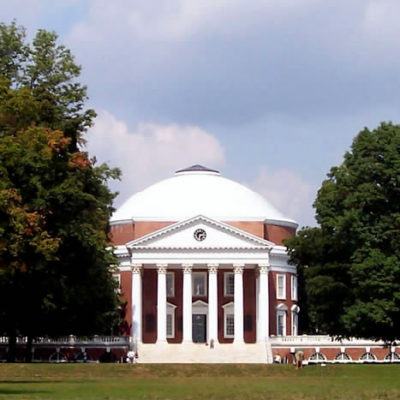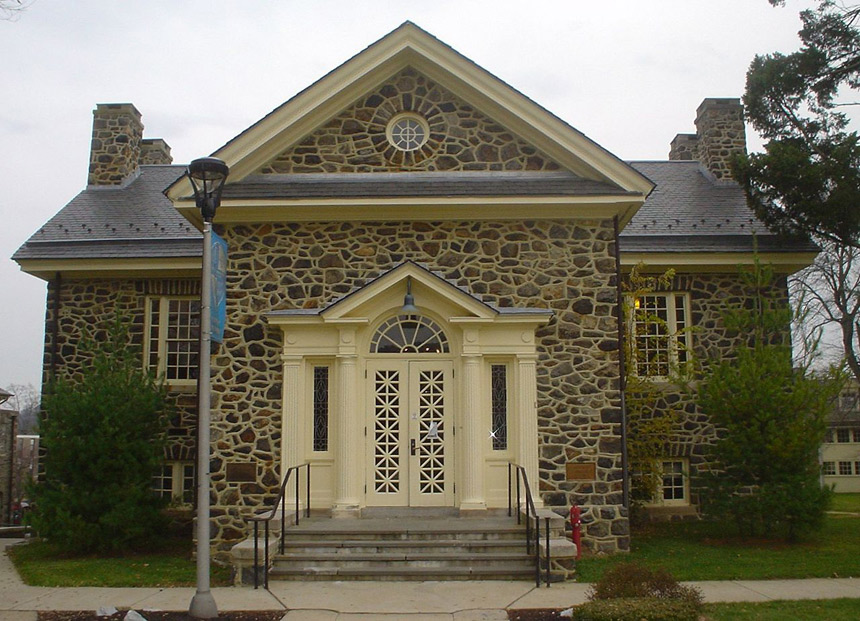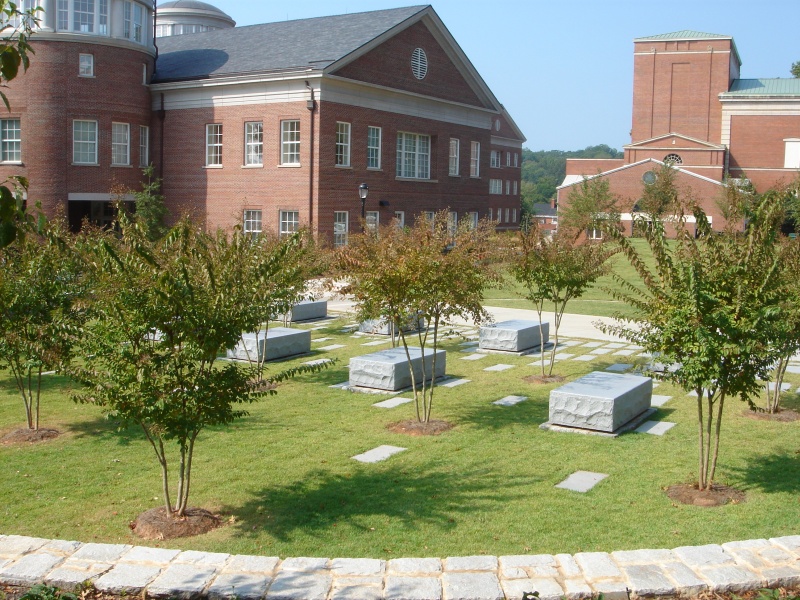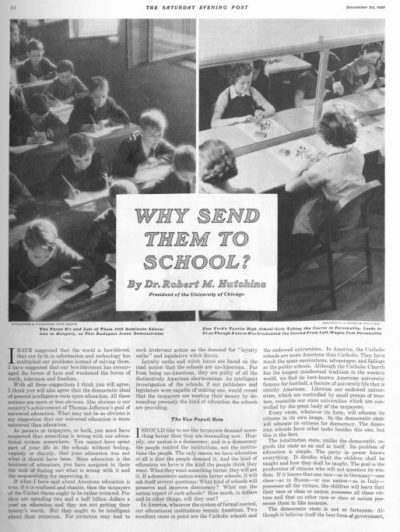Is Your Child’s School Being Unfairly Penalized?
No moral intuition is more hardwired into Americans’ conception of economic justice than equality of opportunity. While some of us may be rich and others poor, we are willing to accept such outcomes as long as everyone has an equal shot at success. The moral legitimacy of the market’s distribution of income rests on a presumption that our system rewards ingenuity, hard work, talent, and risk-taking rather than race, class, family connections, or some other advantage we consider unearned, illegitimate, or unfair.
“In every wise struggle for human betterment, one of the main objects, and often the only object, has been to achieve in large measure equality of opportunity,” declared President Theodore Roosevelt in a speech in Osawatomie, Kansas, in 1910, laying out the “square deal” he believed was due to all Americans.
In a speech later that year, Roosevelt took pains to reassure members of the New Haven Chamber of Commerce that his notion of equal opportunity fit squarely within the context of a market economy. “I know perfectly well that men in a race run at unequal rates of speed. I don’t want the prize to go to the man who is not fast enough to win it on his merits, but I want them to start fair.”
For the first time in American history, the steady march toward greater equality of opportunity seems to be headed in the opposite direction.
Equality of opportunity, of course, taps into the conception Americans have of themselves as a people who fought one war to shake off the tyranny of a British monarchy and aristocracy and another to shake off the chains of slavery, a people who welcomed wave after wave of ambitious immigrants yearning for a better life. Yet there is now a sizable and growing body of evidence that, despite elimination of most legal barriers to equality of opportunity, the luck of which parents you were born to continues to play an outsized role in determining economic success. Whether it’s by way of the genes we inherit (nature) or the circumstances in which we are raised (nurture), the results of this parental lottery are more important than ever in determining our natural capabilities and the degree to which we are able to develop those capabilities and bring them to an increasingly competitive marketplace. Indeed, for the first time in American history, the steady march toward greater equality of opportunity seems to be headed in the opposite direction.
Our education system is no longer serving its historical role of equalizing economic opportunity and increasing social mobility. Rather, it has become an instrument by which children lucky enough to be born into favorable circumstances increase their economic advantage over those who were not.
It was 65 years ago that the Supreme Court, relying largely on evidence and expert opinion from social scientists, ruled in Brown v. Board of Education that sending black children to separate schools was inherently unequal. Now it is time to extend that constitutional principle and declare that it is no longer acceptable to organize and finance public education in a way that segregates poor children in separate schools.
Because of our reliance on local property taxes to fund public schools, and public school systems that organize schools around residential neighborhoods, we have a system that in many places provides less funding, less effective teachers, and worse facilities to poor students who require more resources and better teachers to reach comparable educational goals. Moreover, there is clear evidence from social science research that segregating poor children in the same schools deepens their disadvantage. The only practical way to end this class segregation in education is the same way racial segregation was ended — with a Supreme Court finding that segregating poor students in the same schools denies them the equal protection of the law guaranteed by the Constitution.
As it happens, the Supreme Court explicitly rejected that view in 1973 in a case that few remember today, San Antonio Independent School District v. Rodriguez. In a 5–4 ruling, the Court — which only two decades before, in Brown, had recognized the importance of public education to a democratic society and a child’s success in later life — reversed course and declared that public education was not a fundamental right under the Constitution. It also found that discrimination on the basis of class did not warrant the same strict scrutiny as discrimination on the basis of race. Writing for the majority, Justice Lewis Powell worried that if public education were to be treated as a fundamental right, the Court would find itself on a slippery slope that would also require it to give similar status to housing and medical care.
It is time to revisit those issues. One reason is new evidence from social science studies showing that the socioeconomic characteristics of a child’s classmates are a better predictor of educational achievement than a child’s own socioeconomic background. Another is the change in case law. In the intervening years, there has been a long line of Court decisions striking down affirmative action plans at universities or guaranteeing parents control over their children’s schooling, in which the Court’s conservative majority recognized something that sounds very much like a constitutional right to education. With a series of education reform bills, Congress has also established a strong federal interest in ensuring that all students attain minimal levels of educational achievement, with a particular emphasis on low-performing students and school districts. All of these developments provide a solid legal basis to ask the Court to reconsider the issue and declare that Rodriguez was wrongly decided.
There is nothing sacred about the idea that municipalities and school districts have to have the same boundaries, or that public education needs to be funded primarily through property taxes. To assure equal access to an adequate education, the federal courts could require states to redraw school district boundaries in ways that would end desegregation by class and put rich and poor students in the same school systems. Courts could order states to devise statewide funding formulas that would begin to break the pernicious link between local property values, per-pupil spending, and educational achievement. And judges could even insist that the newly redrawn school districts rely on student choice for school assignments and make extensive use of magnet schools.
I don’t underestimate the political and legal difficulties in bringing about such a radical restructuring of public education. I am old enough to remember the bruising battles over busing, and I am aware that the process of bringing racial integration to public schools has hardly been a smashing success. Class integration would be no less challenging, but it is also no less of a moral imperative.
It is worth recalling that the campaign to overturn the separate but equal doctrine in Plessy v. Ferguson energized a generation of Americans in the 1960s. Overturning Rodriguez and establishing the fundamental right of all children to a decent education could be the legal issue that energizes a new generation eager to ensure that history continues to bend toward justice. It will take patience, persistence, and political courage, but this is the kind of defining moral issue that is worth the effort.
From Can American Capitalism Survive? by Steven Pearlstein, copyright © 2018 by the author and reprinted by permission of St. Martin’s Press.
Featured image: Shutterstock
Considering History: The Real Crisis Facing Public Higher Education in America
This series by American studies professor Ben Railton explores the connections between America’s past and present.
On March 22, President Trump issued an Executive Order that affects one of America’s most significant, shared spaces and communities: our institutions of higher education. Entitled “Improving Free Inquiry, Transparency, and Accountability at Colleges and Universities,” the EO threatens to remove federal funding from institutions of higher education that do not “promote free inquiry” on their campuses. Although the EO itself does not spell out the meaning of that phrase further, it has been celebrated by conservative groups such as Turning Point USA, who believe the EO to be an endorsement of their critiques of universities where far-right speakers have been either disinvited from speaking or protested when they did speak.
There isn’t a free speech crisis on America’s college campuses, nor is this striking Executive Order genuinely seeking to address such an issue. Yet this moment nonetheless offers us an opportunity to consider a legitimate crisis facing public higher education in America: The abandonment of funding of these institutions. This issue threatens the founding and enduring mission and role of these schools in our society.

America’s first public universities were created as overt alternatives to the Revolutionary era’s elite, religious private colleges such as Harvard and Yale. Thomas Jefferson’s University of Virginia, for example, represented the nation’s first non-sectarian university, one intended to have no affiliation with or sponsorship from a religious faith. The other earliest public universities, such as the University of Georgia (founded in 1785) and the University of North Carolina (founded in 1795), were likewise intended to open up higher education to students beyond the wealthy planter elites in these states. While certainly their target audiences remained white male students, they nonetheless represented first steps in the democratization of American higher education.

Over the course of the 19th century, that democratizing promise was gradually extended to additional American communities. The creation of the institutions that have become known as Historically Black Colleges & Universities (HBCUs), a process that began with the 1837 founding of Cheyney University of Pennsylvania, made higher education available to African American students for the first time. Many of the earliest women’s colleges in America were private institutions, but in 1884 the Mississippi state legislature established the public women’s Industrial Institute & College (later Mississippi University for Women), and over the next two decades Georgia (1889), North Carolina (1891), and Florida (1905) founded their own public women’s colleges as well.
The 19th century also saw the founding across the country of a number of public teaching academies, generally known as Normal Schools, that likewise included (if they were not indeed initially limited to) female students and paved the way for another evolving system of public colleges and universities that endures to this day. The history of the institution where I teach, Fitchburg State University in Massachusetts, illustrates that legacy: the State Normal School in Fitchburg was initially founded in 1894, added a Bachelor’s degree in “practical” arts in 1930, changed its name to the State Teachers College at Fitchburg in 1932, and then became Fitchburg State College in 1965 (and Fitchburg State University in 2010).
Yet FSU’s 21st century situation also reflects the central challenge and crisis facing public higher education in Massachusetts and around the country. Over the last two decades or so Massachusetts has largely disinvested in public higher education. Between 2001 and 2018 the amount Massachusetts spends per resident student in our public universities has decreased by 31%. According to the Center on Budget and Policy Priorities, of the 49 states analyzed over the full 2008-2018 period, after adjusting for inflation, 45 spent less per student in the 2018 school year than in 2008.
While this decline in funding affects every aspect of public higher education, it has hit students particularly hard: According to the National Center for Education Statistics, prices for undergraduate tuition, fees, room, and board at public institutions rose 34 percent between 2006 and 2016 (adjusting for inflation). Total student loan debt is $1.52 trillion, a 302 percent increase since 2004.
Each of these trends is linked to and influenced by a number of factors, but the overall trends are all too clear: legislators and politicians have increasingly chosen not to fund public higher education in the 21st century; and the costs have been passed on to the institutions and, especially, their students. While that trend has been perhaps particularly pronounced in Massachusetts (which now ranks 34th in the nation in per resident student state spending), it has at the same time been taking place throughout the nation (and of course is paralleled by similar disinvestments in public secondary and primary education). If these trends continue, public higher education might soon become something it has not been since its earliest iterations (if ever): a community that only the wealthiest and most privileged Americans can afford to join.

Here in Massachusetts, two proposed state laws seek to counter these trends and begin to chart a new way: the Promise and Cherish Acts, which would offer significant funding shifts and increases for public primary, secondary, and higher education over the next five years (among many other features). This past Tuesday, Fitchburg State hosted one of the numerous Fund Our Future forums taking place throughout the state, to highlight these crises and the proposed bills, and to feature the voices of students, faculty and staff, and community members testifying to both the challenges they face and the value of public higher education. What I saw and heard there was the best of what public higher education has meant in America and can mean in the 21st century, if we live up to our legacies, reverse our current trends, and recognize the true crisis facing American higher education.
80-Year-Old Report Predicts DeVos’s Attitude on Public Education
The vote for Betsy DeVos’s Secretary of Education nomination is expected to occur next week, and a tie-breaking vote from Vice President Mike Pence is likely to confirm the cabinet appointment.
DeVos has faced criticism over her performance at her confirmation hearing as well as her history of large donations to the Republican Party. Republican Senators Susan Collins and Lisa Murkowski said they would vote against Devos’s confirmation, citing her preoccupation with school vouchers and lack of experience in public education. Devos’s approach to education reform seems, to many, to be a diversion of public funds to religious schools and charter schools.
The United States has argued about public education reform for decades. In the 1937 article “Why Send Them to School?” from the Post (read the full article below), University of Chicago president Robert M. Hutchins identified many pitfalls and successes of public education.
Hutchins called for federal support of public education, and he even argued a rigorous appointment process for the then-nonexistent Secretary of Education Cabinet position:
“If we are going to have a program of Federal support, we shall want it to be directed intelligently. The only way we can insure this kind of direction is to set up a department of the National Government, headed by a Secretary of Education in the Cabinet. Vigilant taxpayers and vigilant members of the affected profession would see to it, as they have in the erection of other Federal agencies, that the personnel of this new department was recruited not from the roll of party workers but from experts in the field.”
Hutchins made his case for higher wages for teachers as well as more freedom in the classroom, warning against “legislative ‘investigations’” that amounted to “loyalty oaths” paving the way towards propaganda: “We shall have depressions in the future, and the parents and taxpayers of America will do well, while everything is still rosy, to protect the freedom to teach against the attacks that will occur again.” Anyone familiar with the laments of many public educators today will recognize Hutchins’s call for empowerment of teachers, politically and financially, from almost 80 years ago.
In his story Hutchins expresses the essence and purpose of education in a manner that causes one to wonder whether these ideas have been lost in today’s public education debate. He notes the school’s function is neither to create adults who believe “everything they read in the newspapers” nor any that “accept ours as the best of all possible worlds.”
